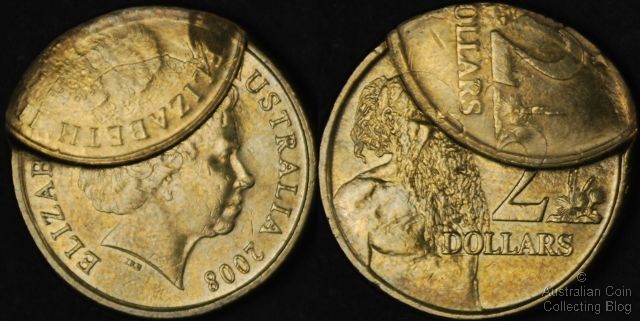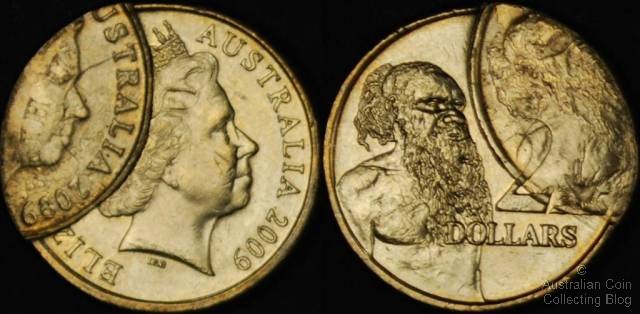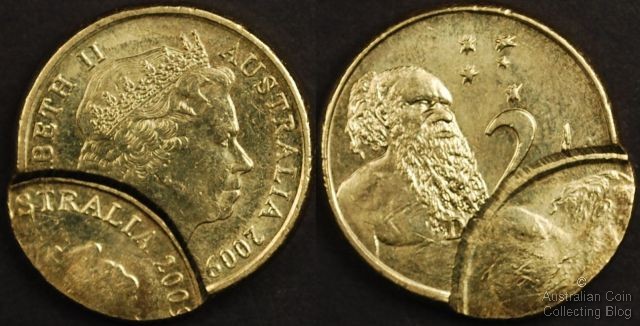As published in the Australasian Coin and Banknote Magazine August 2010.
Written by the www.australian-coins.com/blog team with thanks to John Mulhall for getting it to print!
Lot 401 in Downies Auction 303 held in November 2009 was a double struck 2008 $2 error coin. The lot realised $1550 (plus buyers premium) and was in lovely almost uncirculated condition with the second strike overlaying the first by about 40%. As keen followers of the decimal error market this coin was the first double struck $2 that had become available in at least the last 5 years. We found the error to be remarkable given the scarcity of $2 coin errors, which we've found to be the least common error coin among all denominations in the decimal series. The reason for this isn't really known but possibly the answer lies in the lower mintages of the $2 coin.
To our surprise early this year another double struck 2008 $2 coin appeared on eBay being sold by a coin dealer from Sydney. That coin, graded as extremely fine or perhaps a little better sold for $865. An image of this coin can be seen in Figure 1. This coin was followed just a couple of weeks later by another 2008 double struck coin being sold by a well known Sydney dealer via mail order for $1000. We quickly contacted the dealer interested in purchasing the coin but it had sold in a very short time frame. So interestingly 3 of these double struck coins had appeared on the market in just 4 months!
Fast forward to March 2010 and yet another double struck $2 coin appeared on eBay being sold by the same seller as the first eBay coin. However, this one was a 2009 coin, had two clear dates of 2009 visible and was yet again graded as EF to AU. See Figure 2 for an image of this coin. This coin sold for just a touch over $800 and appears to be the best example sold to date. A 5th and (to date) final double struck $2 was listed by the same eBay seller/dealer in June 2010, this one was a similar grade to all the others and was a bargain for the purchaser, selling for just $455 (see figure 3).
 Figure 1
Figure 1 Figure 2
Figure 2 Figure 3
Figure 3What is a Double Struck Coin?
Double struck coins can take a few different forms, but the most common usually has a second strike that is rotated and off-centre from the first strike by a certain percentage. The double struck $2 coins we've discussed here are all off-centre around 60-70%. They've occurred when a coin is struck and then fails to clear the coining chamber completely before the next strike occurs. This results in a second strike partially obscuring the first. The coin may rotate as it partially exits the press resulting in different parts of the coin design overlaying the first strike. The second strike almost always results in the coin taking on an irregular shape (i.e. no longer round) because it is not constrained by the collar. This would mean that the coin would likely foul coin counting machines and vending machines while still weighing exactly same as a normal coin. From an error collectors point of view double struck coins with two visible dates are the most desirable examples.
Where did the Coins Come From?
We've heard a couple of theories about how these errors reached the collector market. The first is that the coins were 'mint sport' of the type similar to double obverse or double reverse coins minted in the 1970's. According to this theory the coins would have then been spirited from the mint and released onto the market. Upon showing one of the imaged coins to well known numismatists and error experts it was suggested that given the current setup of presses at the RAM and increased security to prevent theft from the mint that this first theory is more or less implausible.
The second (and much more likely theory) is that these errors occurred in the normal production process and were bagged up automatically by the mint's highly automated systems into mint bags before being released to security companies for rolling or bagging and subsequent distribution. We could then postulate that the highly irregular shape of the double struck coins caused them to be rejected by the security companies rolling or counting machines. The errors then somehow escaped the security company and ended up in the hands of a couple of dealers in Sydney. Given that 4 of the 5 coins to date have been sold by Sydney based dealers we can only assume that most of these errors have been sent to security companies in that area.
What Next?
Will any more of these errors appear? Clearly something has changed at the Royal Australian Mint to allow these errors to escape. Whatever has changed, it has only happened in the last year or two as we're aware of no earlier examples than the first two 2008 coins. Perhaps more $2 double strikes will appear and it will be intriguing to see if any other denominations might appear. A double struck $1 coin, for example, would be a holy grail for the authors, two of the keenest decimal error collectors we know!
Update June 2013: This has become one of the most common double struck decimal coin error with the majority being dated 2009. There must have been a faulty press at the Mint at this time. You'll be pleased to know that the authors have added that holy grail coin error to their collection!
Posted by harrisk at July 31, 2010 4:16 PM
Subscribe to our Newsletter


